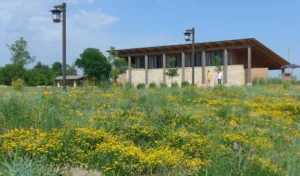Adventure seekers often face a dilemma between outdoor pursuits and garden care. Native plant landscaping provides a perfect balance, creating vibrant ecosystems that need minimal maintenance while promoting environmental stewardship. Why are native plants ideal for active adventurers, and how can they support local biodiversity and reduce carbon footprints? The benefits of native plant landscaping and adventure living hold intriguing possibilities.
Key Takeaways
- Native plant landscaping requires minimal upkeep, ideal for adventure seekers with active lifestyles, reducing maintenance efforts.
- Incorporating native plants supports local ecosystems, preserves biodiversity, and provides habitat for native wildlife.
- Native plants reduce environmental impact by conserving water, eliminating fertilizers and pesticides, and absorbing carbon dioxide.
- By choosing native plants, outdoor enthusiasts can create a sustainable oasis that aligns with their values of environmental responsibility.
- Native plant landscaping supports ecological harmony, reducing the need for mowing, pruning, and other maintenance tasks, freeing up time for adventure.
Low Maintenance for Active Lifestyles
Native flora landscaping proves to be an ideal choice for adventure enthusiasts, as it requires minimal upkeep, allowing them to focus on their active lifestyles. This low-upkeep approach is made possible by the following benefits of native plant landscaping:
- Drought tolerance, reducing the need for frequent watering.
- Pest and disease resistance, minimizing the use of pesticides and fungicides.
- Native soil adaptation, eliminating the need for fertilizers and soil amendments.
- Self-sustaining growth, requiring less pruning and grooming.
Native Plants Support Local Ecosystems
Moreover, offering low-maintenance benefits, native plant landscaping plays a crucial role in preserving local ecosystems by providing a habitat for native wildlife and supporting biodiversity. By incorporating native plants into your garden, you’re supporting the delicate balance of local ecosystems, which is vital for the survival of native species and maintaining ecological harmony.

Reducing Carbon Footprint at Home
By choosing plants that flourish in local conditions, homeowners can significantly reduce their environmental impact, as indigenous plant landscaping eliminates the need for excessive watering, fertilizers, and pesticides, which are significant contributors to greenhouse gas emissions.
Here are some benefits of native plant landscaping in reducing environmental impact:
- Less water consumption: Native plants require minimal watering, reducing energy used for pumping and treating water.
2. No fertilizers or pesticides: Indigenous plants thrive without chemicals, minimizing their production and transportation emissions. - Less mowing and maintenance: Native plants often require less upkeep, reducing fuel consumption from lawnmowers and other equipment.
- Carbon sequestration: Native plants absorb carbon dioxide from the atmosphere, further reducing the environmental impact.
Native Landscaping for Adventure Seekers
Many outdoor enthusiasts, seeking to balance their love of adventure with a commitment to environmental stewardship, are exploring the benefits of native plant landscaping in their own backyards. By incorporating native plants, adventure seekers can create a sustainable oasis that supports local ecosystems, reduces maintenance, and enriches biodiversity, aligning with their values of environmental responsibility.
Frequently Asked Questions
Can I Mix Native Plants With Non-Native Plants in My Garden?
While it’s possible to mix indigenous and non-native plants, it’s crucial to consider the potential consequences, such as invasive species outcompeting native plants, disrupting local ecosystems, and altering biodiversity.
Do Native Plants Require Specialized Gardening Tools or Equipment?
Indigenous plants typically do not require specialized gardening tools or equipment, as they are adapted to thrive in local conditions, making maintenance and care more straightforward and efficient for gardeners.
Are Native Plants Only Suitable for Large Outdoor Spaces?
No, indigenous plants are not exclusive to large outdoor spaces; they can thrive in small gardens, balconies, and even indoor containers, offering a versatile and low-maintenance option for adventure lovers with limited space.’
Can I Use Native Plants to Create a Themed Garden, Like a Zen Garden?
Yes, indigenous plants can be used to create a themed garden, such as a zen garden, by selecting species that align with the desired aesthetic and incorporating design elements that evoke a sense of tranquility.
Do Native Plants Attract More Pests or Insects Than Non-Native Plants?
Indigenous plants tend to attract fewer pests and insects than non-native plants, as they have developed alongside local wildlife, nurturing a balanced ecosystem; this diminishes the need for pesticides and preserves biodiversity.
Conclusion
Native plant landscaping offers a harmonious relationship between human activity and environmental stewardship. By incorporating native plants, adventure seekers can minimize their ecological footprint while maintaining a thriving garden. This approach reduces water consumption, eliminates the need for fertilizers and pesticides, and supports local biodiversity. Ultimately, native plant landscaping empowers individuals to prioritize outdoor pursuits while promoting a sustainable coexistence with the natural environment.
You May Also Like:


